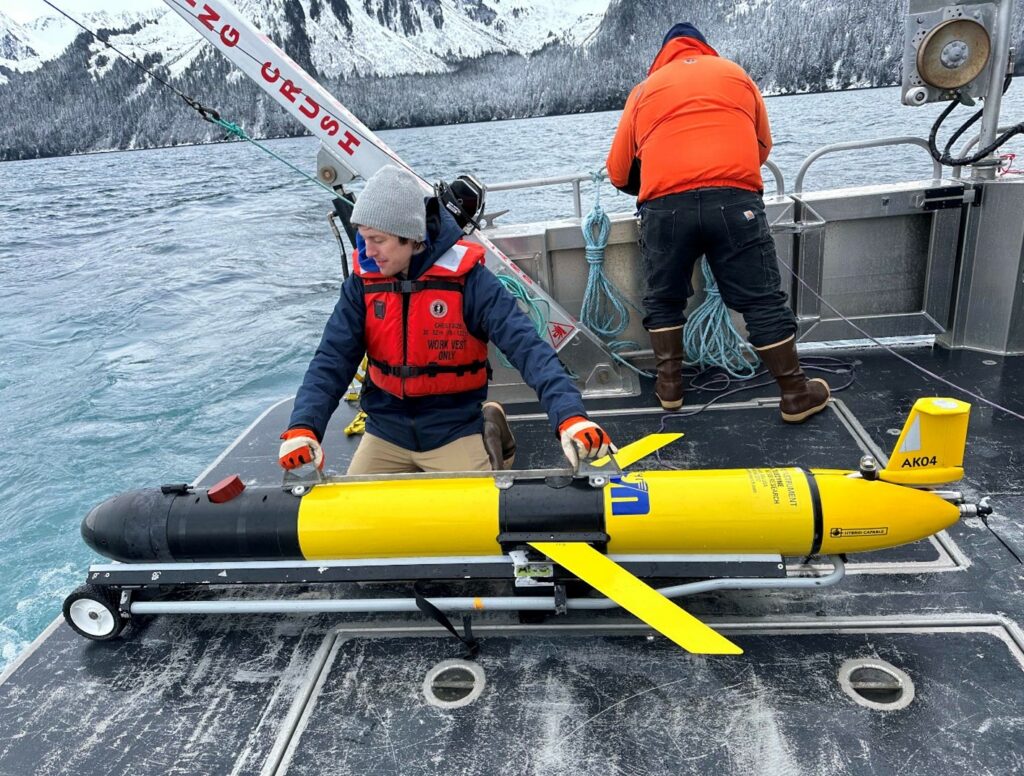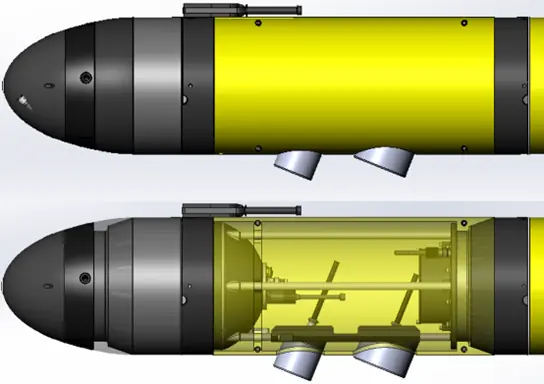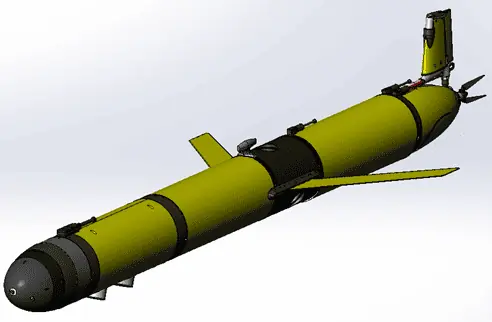
Teledyne Marine and Kongsberg Discovery have announced a collaborative effort to integrate the Kongsberg EK80 WBT Mini Scientific echo sounder onto the Teledyne Slocum G3s Glider. Both companies will be exhibiting at Oceanology International 2024 in London March 12-14.
The EK80 WBT Mini
The Kongsberg EK80 WBT Mini is a compact version of the highly efficient Wide Band Transceiver (WBT) used by marine research vessels worldwide. Its compact size and energy-efficient design make it perfect for installation on subsea platforms such as the Slocum Glider. The scientific echo sounder is used to identify and quantify a wide range of targets such as fish, plankton, bubbles, oil droplets, and physical oceanographic features such as turbulence.
The Slocum G3 Glider
The Slocum Glider is one of the world’s most prolific autonomous gliding platforms, a subsea vehicle that uses changes in buoyancy to efficiently move through the water, allowing it to persistently monitor the ocean water column for months at a time, and transmit gathered data shoreside via an iridium satellite connection. Slocum Gliders are used across a wide-ranging set of missions, including deployments serving Oceanographers, Fisheries, Energy Producers, and Military customers.

A Slocum glider-mounted EK80 echo sounder provides a solution for many applications across several fields, including:
- Fisheries Research
- Biological Oceanography
- Chemical Oceanography
- Environmental monitoring
- and more
Integration
The EK80 integration on the Slocum houses the WBT Mini electronics in a pressure vessel forward of the glider’s buoyancy engine, behind the nose sonar dome. Two transducers are mounted in a flooded wet bay between this pressure vessel and the glider’s forward section. Users are offered transducer frequency options of 120kHz / 200kHz or 200kHz / 333 kHz, either upward or downward facing.
The combination of these technologies allows for long-term data gathering of acoustic target density and dispersal throughout the water column of a specified area. It allows users to understand how changes in climate, environment, or human-driven factors affect a water mass’s ecology, especially when combined with other available sensing options on the glider that collect biogeochemical and physical ocean data.
Teledyne has previously installed the EK80 onto its Slocum glider on a project basis for multiple customers with great early success.
The University of Alaska Fairbanks’ glider, Gretel, has been deployed several times with the EK80 gathering valuable data for fisheries research. This collaborative effort provides a formal and streamlined integration. Sales of this new echo sounder package have already commenced with scientists at Akvaplan-niva of Norway and the University of Delaware ordering the first units for delivery summer of 2024.
“The integration of the scientific echo sounder EK80 from Kongsbergm, in the Slocum glider G3 from Teledyne, will allow harvesting unique data to describe the biological structure and functioning of the pelagic ecosystem across depths,” said Lionel Camus, Manager Digital Solutions of Akvaplan-niva.
“Akvaplan ‘s marine scientists are excited to have their Slocum G3 rigged with the echo sounder together with the underwater vision profiler (UVP6) with the particular aim to study the ‘super swarm’ of Calanus finmarchicus inhabiting the Norwegian Sea. Further, this new feature will open new applications in marine sciences“.

“I think the integration of this technology is going to significantly enhance the ability of Slocum Gliders to do cutting-edge research,” added Dr. Matt Oliver, Professor of Marine Science and Policy at the University of Delaware.
“Kongsberg Discovery is excited to announce the integration of the EK80 scientific echo sounder into the Teledyne Slocum Glider, enabling collection of long-term data sets of acoustic scattering, and other environmental variables, for academic, military, and commercial applications.”
“This collaboration between Kongsberg Discovery and Teledyne Marine provides a unique and critical solution for gathering high-resolution data at depth,” said Scott Loranger – Acoustician and Applications Scientist at Kongsberg Discovery.
“By bringing the high resolution, high frequency echo sounders deep under water, we will be able to identify, classify, and quantify a wide range of targets out of the reach of traditional shipboard echo sounders.”
“We at Teledyne are extremely excited to introduce the Kongsberg EK80 as a formal sensor offering on the Slocum Glider,” said Shea Quinn, Product Line Manager of the Slocum Glider at Teledyne Marine.
“The Slocum provides a unique new platform for EK80 users to gather long-term echo sounder data throughout the water column at a lower price point than traditional research vessels. Combining the EK80 with other sensor offerings on the Slocum will allow users to gain a unique and comprehensive understanding of their areas of operation”.
Teledyne Marine and Kongsberg Discovery are both exhibiting at the Oceanology International 2024 conference in London March 12-14.










